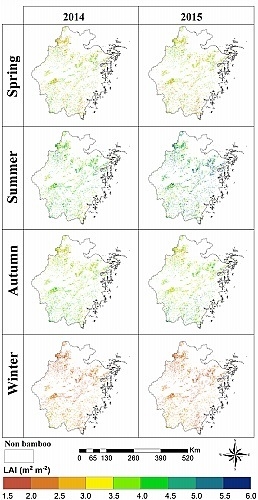Comparison of Two Data Assimilation Methods for Improving MODIS LAI Time Series for Bamboo Forests
Abstract
:1. Introduction
2. Materials and Methods
2.1. Study Area
2.2. Datasets and Processing
2.2.1. Satellite Data
2.2.2. Measurement of LAI
2.2.3. Measurement of Bidirectional Reflectance
2.2.4. Measurement of Leaf Biochemical Parameters
2.3. Bamboo Forest Distribution Extracting
2.4. LAI Assimilation Method
2.4.1. Flow chart of LAI assimilation
2.4.2. LAI dynamic Model
2.4.3. Simulation of CBR
2.4.4. Dual EnKF Algorithm
2.4.5. PF Algorithm
3. Results and Discussion
3.1. Validation of Simulated LBR and CBR
3.2. Performance of Data Assimilation
3.3. Validation of LAI Assimilation
3.4. Assimilating LAI for Bamboo Forests in Zhejiang Province
4. Conclusions
Acknowledgments
Author Contributions
Conflicts of Interest
References
- Chen, J.M.; Black, T.A. Defining leaf area index for non-flat leaves. Plant Cell Environ. 1992, 15, 421–429. [Google Scholar] [CrossRef]
- Jonckheere, I.; Fleck, S.; Nackaerts, K.; Muys, B.; Coppin, P.; Weiss, M.; Baret, F. Review of methods for in situ leaf area index determination: Part I. Theories, sensors and hemispherical photography. Agric. For. Meteorol. 2004, 121, 19–35. [Google Scholar] [CrossRef]
- Chen, J.M.; Cihlar, J. Retrieving leaf area index of boreal conifer forests using landsat tm images. Remote Sens. Environ. 1996, 55, 153–162. [Google Scholar] [CrossRef]
- Plummer, S.E. Perspectives on combining ecological process models and remotely sensed data. Ecol. Model. 2000, 129, 169–186. [Google Scholar] [CrossRef]
- Ma, H.; Song, J.L.; Wang, J.D.; Xiao, Z.; Fu, Z. Improvement of spatially continuous forest lai retrieval by integration of discrete airborne lidar and remote sensing multi-angle optical data. Agric. For. Meteorol. 2014, 189, 60–70. [Google Scholar] [CrossRef]
- Liu, Z.L.; Chen, J.M.; Jin, G.Z.; Qi, Y.J. Estimating seasonal variations of leaf area index using litterfall collection and optical methods in four mixed evergreen–deciduous forests. Agric. For. Meteorol. 2015, 209, 36–48. [Google Scholar] [CrossRef]
- Heinsch, F.A.; Zhao, M.S.; Running, S.W.; Kimball, J.S.; Nemani, R.R.; Davis, K.J.; Bolstad, P.V.; Cook, B.D.; Desai, A.R.; Ricciuto, D.M.; et al. Evaluation of remote sensing based terrestrial productivity from modis using regional tower eddy flux network observations. IEEE Trans. Geosci. Remote Sens. 2006, 44, 1908–1925. [Google Scholar] [CrossRef]
- Yan, M.; Tian, X.; Li, Z.Y.; Chen, E.; Wang, X.F.; Han, Z.T.; Sun, H. Simulation of forest carbon fluxes using model incorporation and data assimilation. Remote Sens. 2016, 8, 567. [Google Scholar] [CrossRef]
- Jiang, J.Y.; Xiao, Z.Q.; Wang, J.D.; Song, J.L. Sequential method with incremental analysis update to retrieve leaf area index from time series modis reflectance data. Remote Sens. 2014, 6, 9194–9212. [Google Scholar] [CrossRef]
- Disney, M.; Muller, J.-P.; Kharbouche, S.; Kaminski, T.; Voßbeck, M.; Lewis, P.; Pinty, B. A new global fapar and lai dataset derived from optimal albedo estimates: Comparison with modis products. Remote Sens. 2016, 8, 275. [Google Scholar] [CrossRef]
- Evensen, G. The ensemble kalman filter: Theoretical formulation and practical implementation. Ocean Dyn. 2003, 53, 343–367. [Google Scholar] [CrossRef]
- Ma, J.W.; Qin, S.X. Recent advances and development of data assimilation algorithms. Adv. Earth Sci. 2012, 27, 747–757. [Google Scholar]
- Xiao, Z.Q.; Liang, S.L.; Wang, J.D.; Jiang, B.; Li, X.J. Real-time retrieval of leaf area index from modis time series data. Remote Sens. Environ. 2011, 115, 97–106. [Google Scholar] [CrossRef]
- Li, X.J.; Xiao, Z.Q.; Wang, J.D.; Qu, Y.; Jin, H.A. Dual ensemble kalman filter assimilation method for estimating time series lai. J. Remote Sens. 2014, 18, 27–44. [Google Scholar]
- Xiong, X.Z.; Navon, I.M.; Uzunoglu, B. A note on the particle filter with posterior gaussian resampling. Tellus A Dyn. Meteorol. Oceanogr. 2006, 58, 456–460. [Google Scholar] [CrossRef]
- Jiang, Z.W.; Chen, Z.X.; Chen, J.; Liu, J. Application of crop model data assimilation with a particle filter for estimating regional winter wheat yields. IEEE J. Sel. Top. Appl. Earth Obs. Remote Sens. 2014, 7, 4422–4431. [Google Scholar] [CrossRef]
- Li, X.; Bai, Y.L. A bayesian filter framework for sequential data assimilation. Adv. Earth Sci. 2010, 25, 515–522. [Google Scholar]
- Jardak, M.; Navon, I.M.; Zupanski, M. Comparison of sequential data assimilation methods for the kuramoto–sivashinsky equation. Int. J. Numer. Methods Fluid 2010, 62, 374–402. [Google Scholar] [CrossRef]
- Leeuwen, P.J.V. Particle filtering in geophysical systems. Mon. Weather Rev. 2009, 137, 4089–4114. [Google Scholar] [CrossRef]
- Montzka, C.; Moradkhani, H.; Weihermüller, L.; Franssen, H.-J.H.; Canty, M.; Vereecken, H. Hydraulic parameter estimation by remotely-sensed top soil moisture observations with the particle filter. J. Hydrol. 2011, 399, 410–421. [Google Scholar] [CrossRef]
- Bi, H.Y.; Ma, J.W.; Qin, S.X.; Zhang, H.J. Simultaneous estimation of soil moisture and hydraulic parameters using residual resampling particle filter. Sci. Chin. Earth Sci. 2014, 57, 824–838. [Google Scholar] [CrossRef]
- Li, H.; Chen, Z.X.; Wu, W.B.; Jiang, Z.W. Crop model data assimilation with particle filter for yield prediction using leaf area index of different temporal scales. In Proceedings of the 4th International Conference on Agro-Geoinformatics, Istanbul, Turkey, 20–24 July 2015; TARBIL: Istanbul, Turkey, 2015; pp. 4311–4315. [Google Scholar]
- Tong, G.F.; Fang, Z.; Xu, X.H. A particle swarm optimized particle filter for nonlinear system state estimation. In Proceedings of the IEEE International Conference on Evolutionary Computation, Vancouver, BC, Canada, 16–21 July 2006; IEEE: Vancouver, BC, Canada, 2006; pp. 438–442. [Google Scholar]
- Yen, T.M. Comparing aboveground structure and aboveground carbon storage of an age series of moso bamboo forests subjected to different management strategies. J. For. Res. 2015, 20, 1–8. [Google Scholar] [CrossRef]
- Yen, T.M.; Lee, J.S. Comparing aboveground carbon sequestration between moso bamboo (phyllostachys heterocycla) and china fir (cunninghamia lanceolata) forests based on the allometric model. For. Ecol. Manag. 2011, 261, 995–1002. [Google Scholar] [CrossRef]
- Food and Agriculture Organization of the United Nations (FAO). Global Forest Resources Asessment 2010: Main Report; Food and Agriculture Organization of the United Nations: Rome, Italy, 2010. [Google Scholar]
- Yen, T.M. Culm height development, biomass accumulation and carbon storage in an initial growth stage for a fast-growing moso bamboo (phyllostachy pubescens). Bot. Stud. 2016, 57, 1–9. [Google Scholar] [CrossRef]
- Chen, X.G.; Zhang, X.Q.; Zhang, Y.P.; Booth, T.; He, X.H. Changes of carbon stocks in bamboo stands in china during 100 years. For. Ecol. Manag. 2009, 258, 1489–1496. [Google Scholar] [CrossRef]
- State Forestry Administration, P.R. China (SFAPRC). Forest Resources in China–The 8th National Forest Inventory; State Forestry Administration, P.R. China: Beijing, China, 2015.
- Yen, T.M.; Wang, C.T. Assessing carbon storage and carbon sequestration for natural forests, man-made forests, and bamboo forests in taiwan. Int. J. Sustain. Dev. World Ecol. 2013, 20, 455–460. [Google Scholar] [CrossRef]
- Zhou, G.M.; Shi, Y.J.; Lou, Y.P.; Li, J.L.; Yannick, K.; Chen, J.H.; Ma, G.Q.; He, Y.Y.; Wang, X.M.; Yu, T.F. Methodology for Carbon Accounting and Monitoring of Bamboo Afforestation Projects in China; INBAR: Beijing, China, 2013. [Google Scholar]
- Li, P.H.; Zhou, G.M.; Du, H.Q.; Lu, D.S.; Mo, L.F.; Xu, X.J.; Shi, Y.J.; Zhou, Y.F. Current and potential carbon stocks in moso bamboo forests in china. J. Environ. Manag. 2015, 156, 89–96. [Google Scholar] [CrossRef] [PubMed]
- Feret, J.B.; François, C.; Asner, G.P.; Gitelson, A.A.; Martin, R.E.; Bidel, L.P.; Ustin, S.L.; le Maire, G.; Jacquemoud, S. Prospect-4 and 5: Advances in the leaf optical properties model separating photosynthetic pigments. Remote Sens. Environ. 2008, 112, 3030–3043. [Google Scholar] [CrossRef]
- Department of Forestry of Zhejiang Province (DFZP). Announcement of Value of Forest Resources and Ecological Functions of Zhejiang Province in 2014; Department of Forestry of Zhejiang Province: Zhejiang, China, 2015.
- Fu, J.H. Chinese moso bamboo: Its importance. Bamboo 2001, 22, 5–7. [Google Scholar]
- Zhou, G.M. Carbon Storage, Fixation and Distribution in Mao Bamboo (Phyllostachys pubescens) Stands Ecosystem; Zhejiang University: Hangzhou, China, 2006. [Google Scholar]
- Xiao, F.M.; Fan, S.H.; Wang, S.L.; Xiong, C.Y.; Zhang, C.; Liu, S.P.; Zhang, J. Carbon storage and spatial distribution in phyllostachy pubescens and cunninghamia lanceolata plantation ecosystem. Acta Ecol. Sin. 2007, 27, 2794–2801. [Google Scholar]
- Chen, J.M.; Deng, F.; Chen, M.Z. Locally adjusted cubic-spline capping for reconstructing seasonal trajectories of a satellite-derived surface parameter. IEEE Trans. Geosci. Remote Sens. 2006, 44, 2230–2238. [Google Scholar] [CrossRef]
- Liu, Y.B.; Ju, W.M.; Chen, J.M.; Zhu, G.L.; Xing, B.L.; Zhu, J.F.; He, M.Z. Spatial and temporal variations of forest lai in china during 2000–2010. Sci. Bull. 2012, 57, 2846–2856. [Google Scholar] [CrossRef]
- Fan, W.L.; Du, H.Q.; Zhou, G.M. Effects of atmospheric calibration on remote sensing estimation of moso bamboo forest biomass. Chin. J. Appl. Ecol. 2010, 21, 1–8. [Google Scholar]
- Dong, D.J.; Zhou, G.M.; Du, H.Q. Effects on topographic correction with 6 correction models on phyllostachys praecox forest aboveground biomass estimation. Sci. Silvae Sin. 2011, 47, 1–8. [Google Scholar]
- Analytical Spectral Devices, Inc. Fieldspec Pro User’s Guide. Available online: http://www.asdi.com (accessed on 7 January 2017).
- Sun, S.B.; Du, H.Q.; Li, P.H.; Zhou, G.M.; Xu, X.J.; Gao, G.L.; Li, X.J. Retrieval of leaf net photosynthetic rate of moso bamboo forests using hyperspectral remote sen-sing based on wavelet transform. Chin. J. Appl. Ecol. 2016, 27, 49–58. [Google Scholar]
- Gu, C.Y.; Du, H.Q.; Zhou, G.M.; Han, N.; Xu, X.J.; Zhao, X.; Sun, X.Y. Retrieval of leaf area index of moso bamboo forest with landsat thematic mapper image based on prosail canopy radiative transfer model. Chin. J. Appl. Ecol. 2013, 24, 2248–2256. [Google Scholar]
- Li, Y.D.; Du, H.Q.; Zhou, G.M.; Gu, C.Y.; Xu, X.J.; Sun, S.B.; Gao, G.L. Chlorophyll content in phyllostachys violascens related to hyper-spectral vegetation indeces and development of an inversion model. J. Zhejiang A F Univ. 2015, 32, 335–345. [Google Scholar]
- Lu, G.F.; Du, H.Q.; Zhou, G.M.; Lv, Y.L.; Gu, C.Y.; Shang, Z.Z. Dynamic change of phyllostachys edulis forest canopy parameters and their relationships with photosynthetic active radiation in the bamboo shooting growth phase. J. Zhejiang A F Univ. 2012, 29, 844–850. [Google Scholar]
- Shang, Z.Z.; Zhou, G.M.; Du, H.Q.; Xu, X.J.; Shi, Y.J.; Lü, Y.L.; Zhou, Y.F.; Gu, C.Y. Moso bamboo forest extraction and aboveground carbon storage estimation based on multi-source remotely sensed images. Int. J. Remote Sens. 2013, 34, 5351–5368. [Google Scholar] [CrossRef]
- Dickinson, R.E.; Tian, Y.H.; Liu, Q.; Zhou, L.M. Dynamics of leaf area for climate and weather models. J. Geophys. Res. 2008, 113, 1–10. [Google Scholar] [CrossRef]
- Huang, M.; Ji, J.; Cao, M.; Li, K. Modeling study of vegetation shoot and root biomass in china. Acta Ecol. Sin. 2006, 26, 4156–4163. [Google Scholar]
- Evensen, G. Sequential data assimilation with a nonlinear quasi-geostrophic model using monte carlo methods to forecast error statistics. J. Geophys. Res. Oceans 1994, 99, 10143–10162. [Google Scholar] [CrossRef]
- Zhang, H.J.; Qin, S.X.; Ma, J.W.; You, H.J. Using residual resampling and sensitivity analysis to improve particle filter data assimilation accuracy. IEEE Geosci. Remote Sens. Lett. 2013, 10, 1404–1408. [Google Scholar] [CrossRef]
- Rasmussen, J.; Madsen, H.; Jensen, K.H.; Refsgaard, J.C. Data assimilation in integrated hydrological modeling using ensemble kalman filtering: Evaluating the effect of ensemble size and localization on filter performance. Hydrol. Earth Syst. Sci. Discuss. 2015, 12, 2267–2304. [Google Scholar] [CrossRef]
- Li, X.J.; Mao, F.J.; Du, H.Q.; Zhou, G.M.; Xu, X.J.; Han, N.; Sun, S.B.; Gao, G.L.; Chen, L. Assimilating leaf area index of three typical types of subtropical forest in china from modis time series data based on the integrated ensemble kalman filter and prosail model. ISPRS J. Photogramm. Remote Sens. 2017, 126, 68–78. [Google Scholar] [CrossRef]
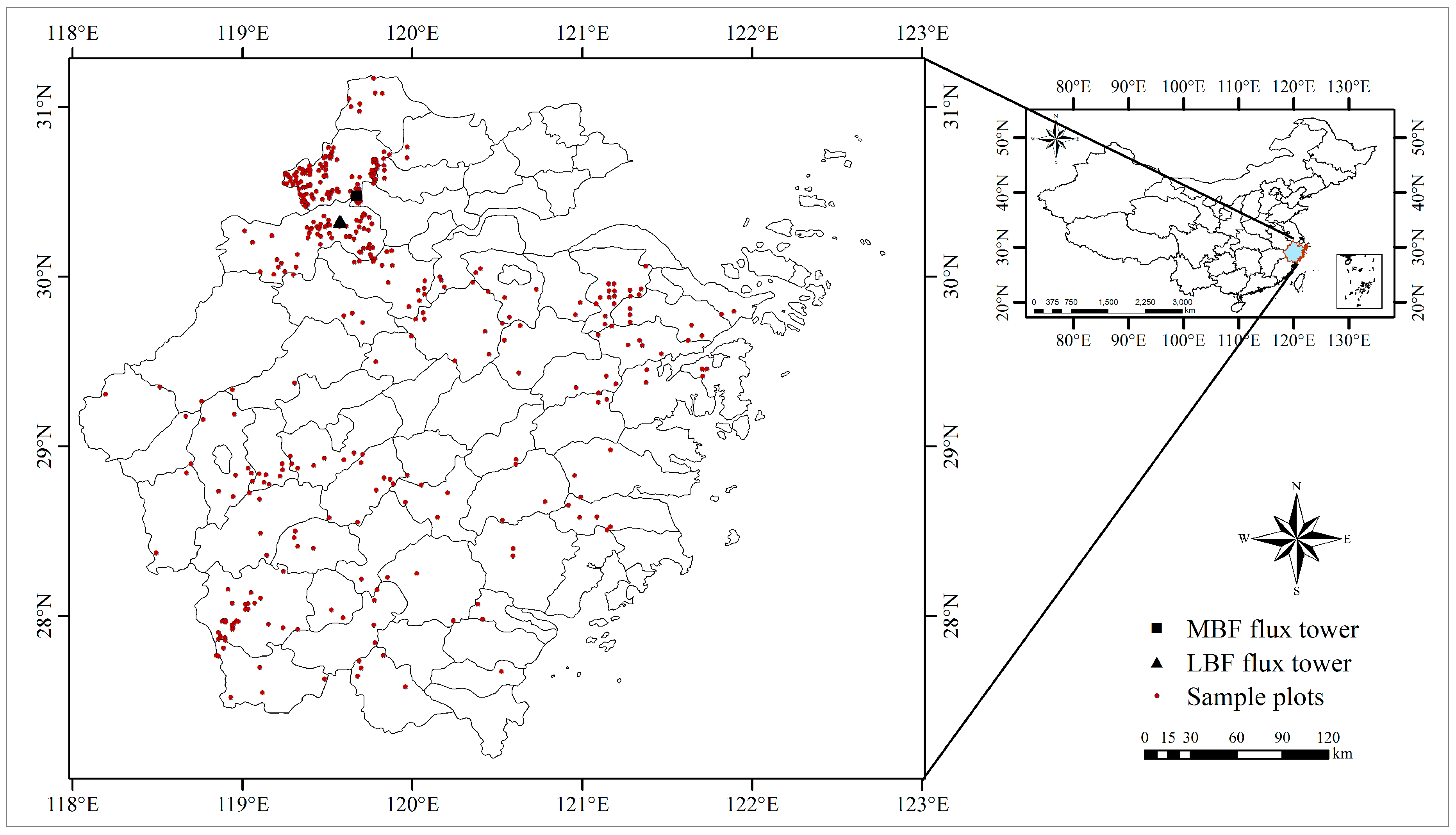
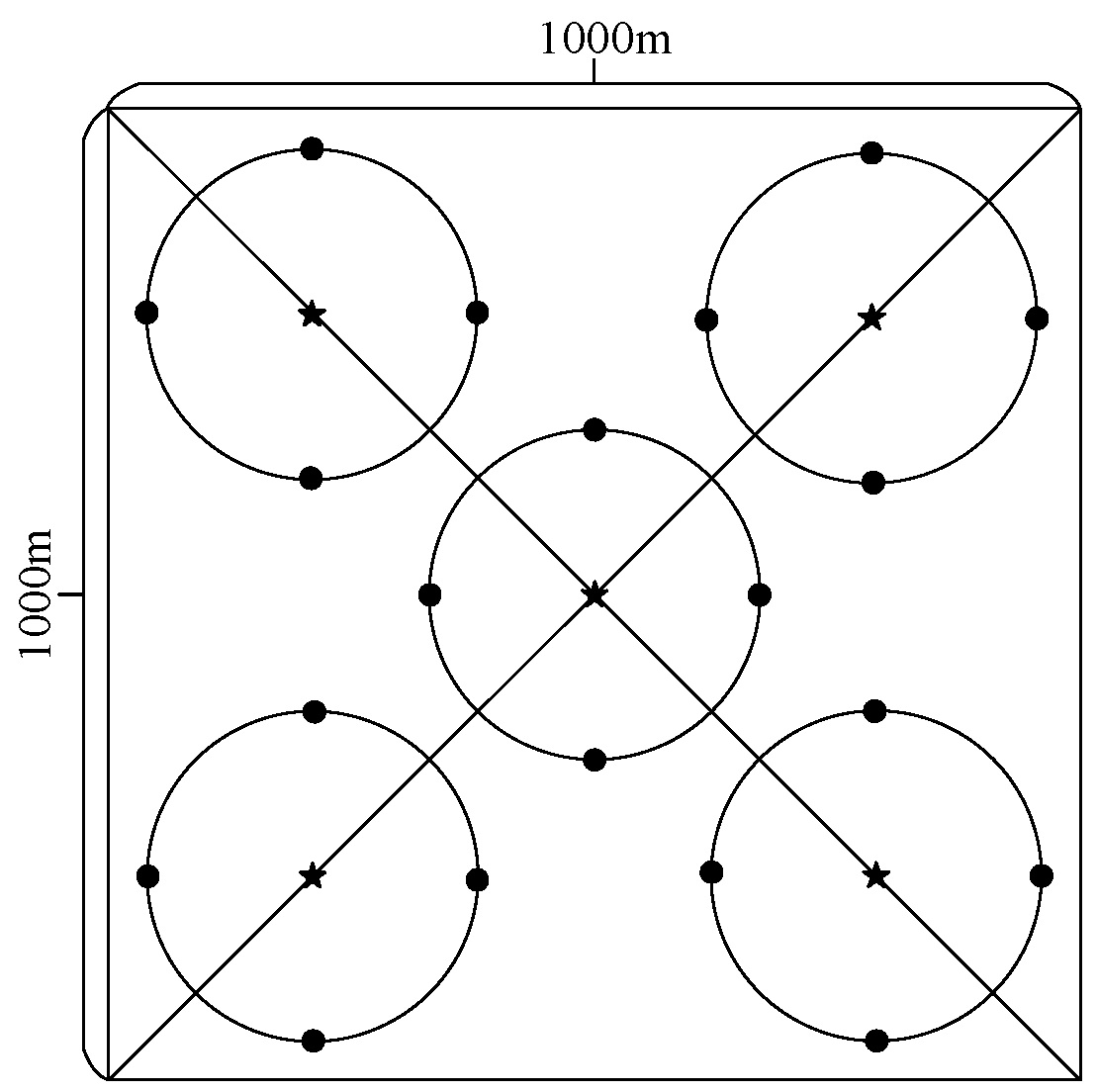
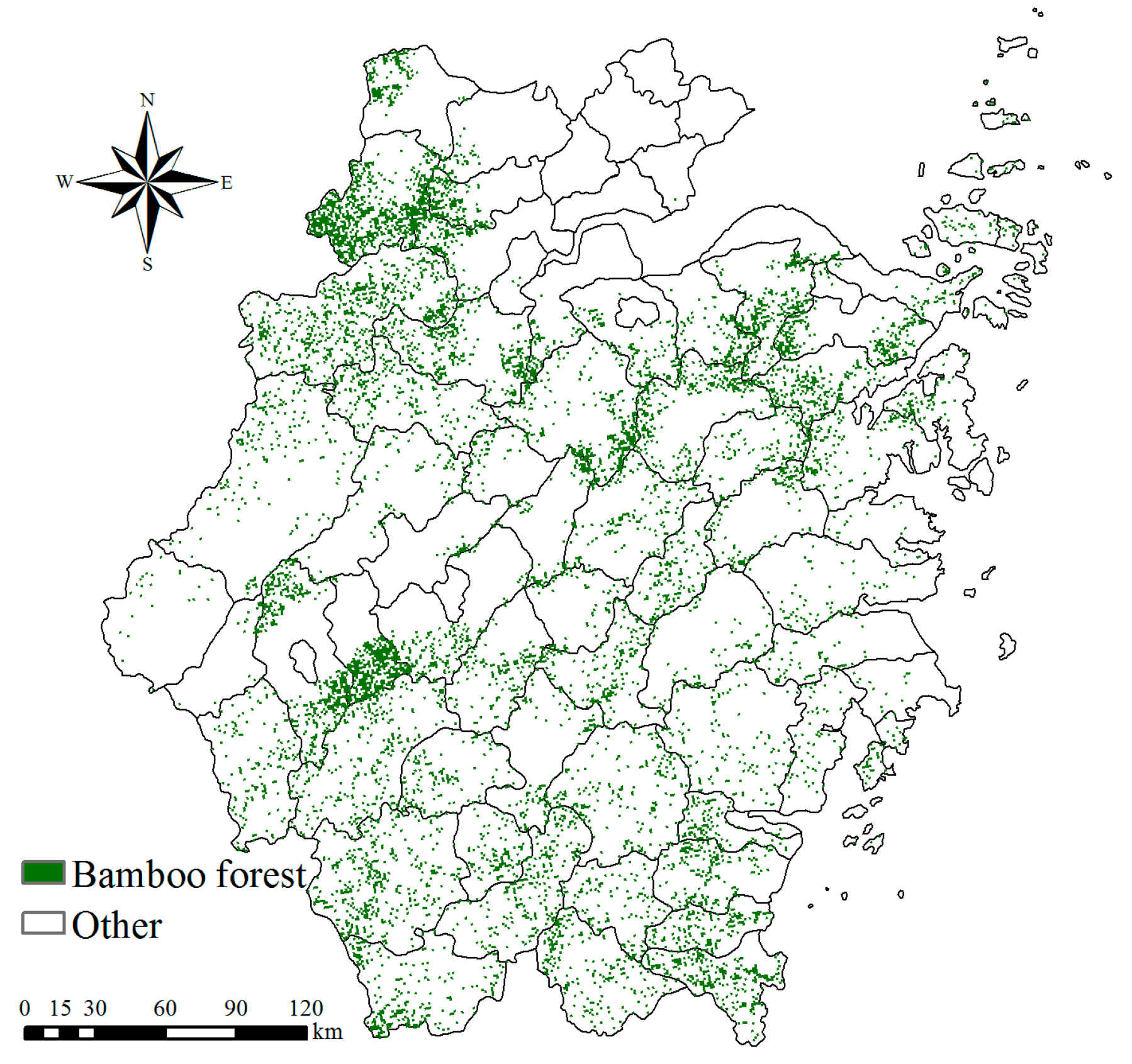

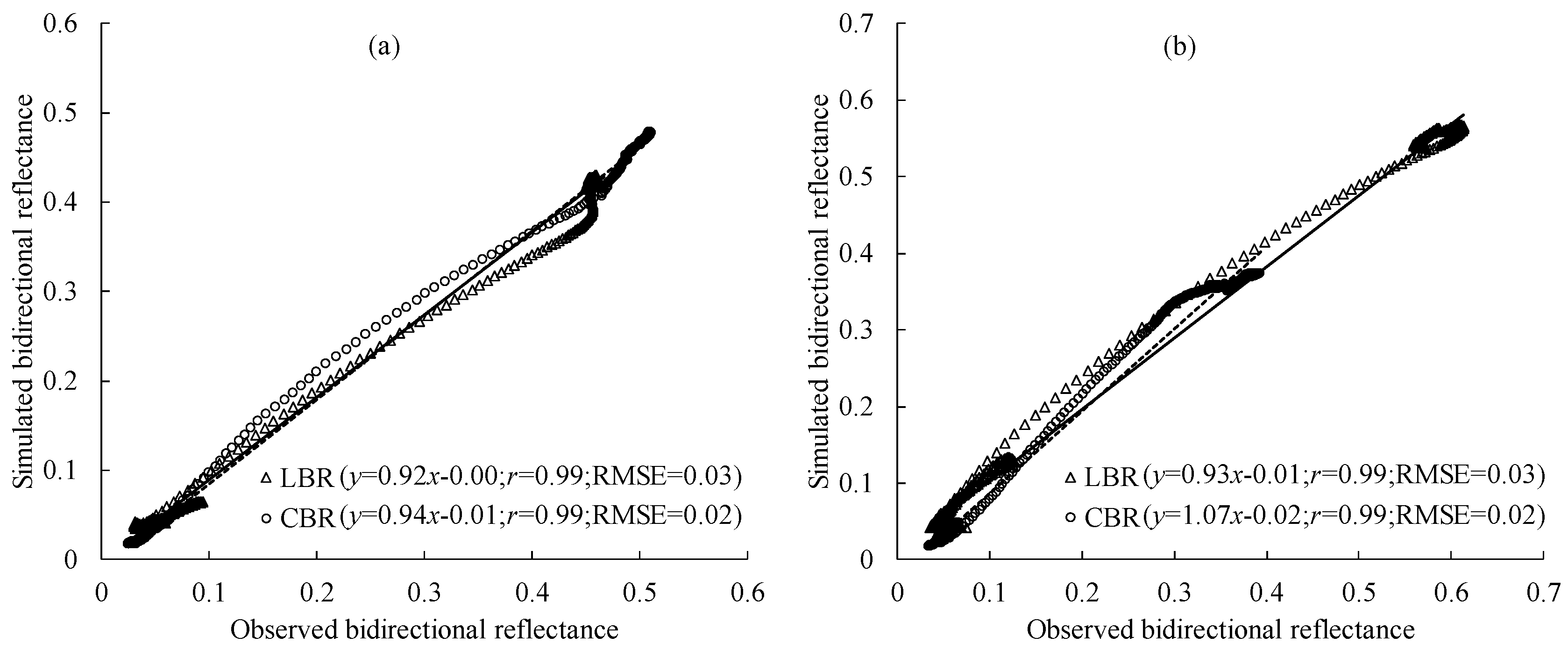
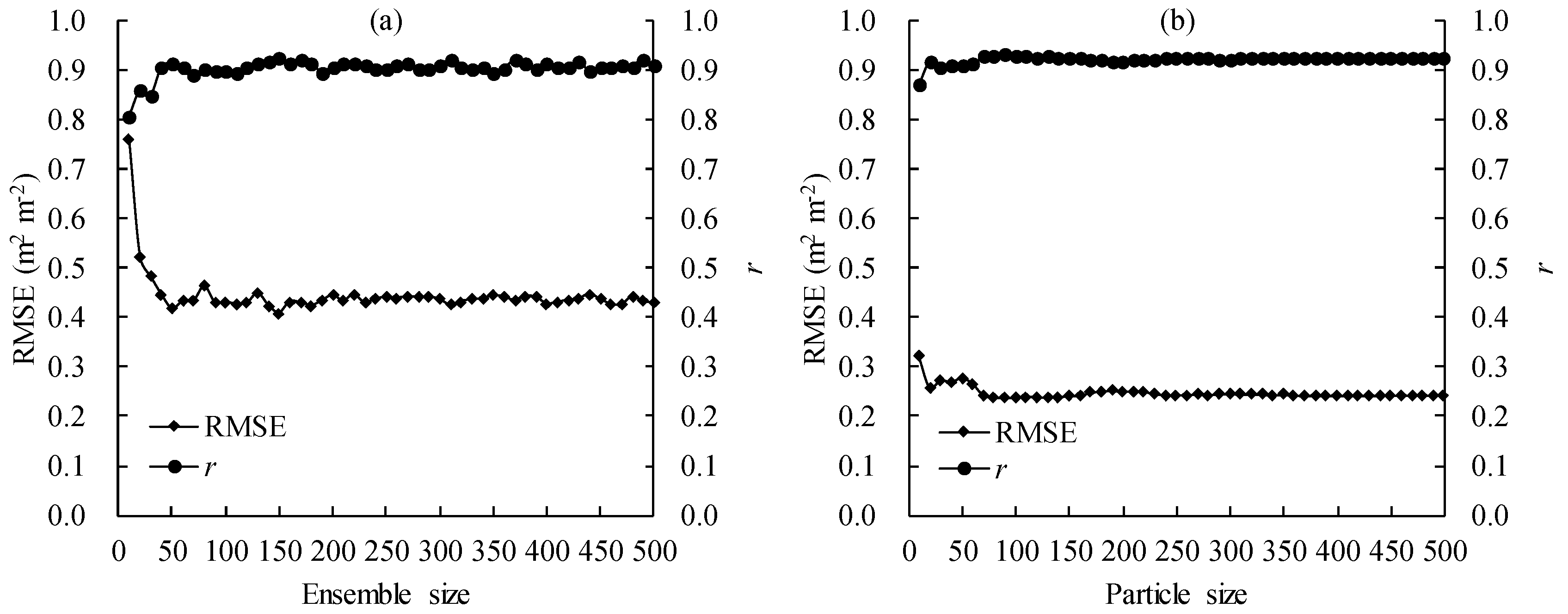
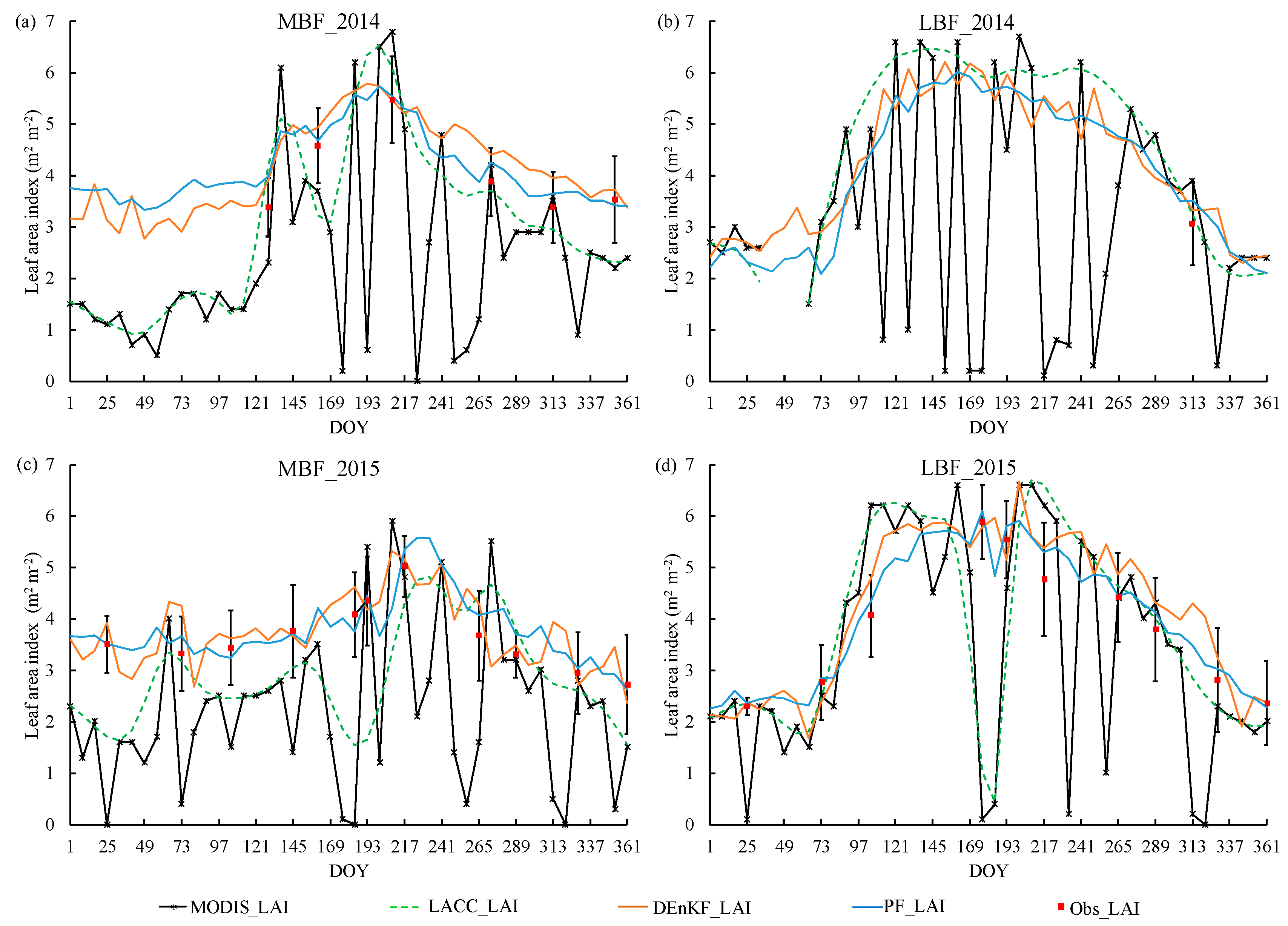
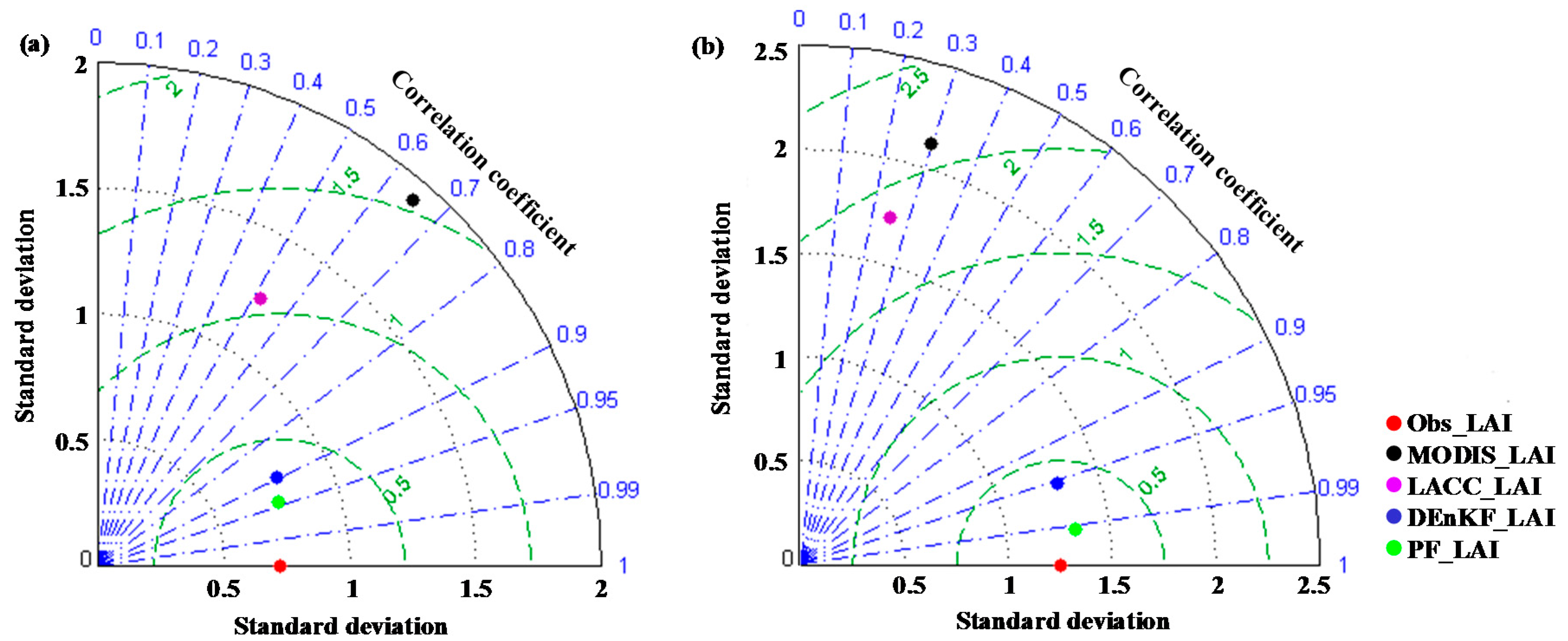
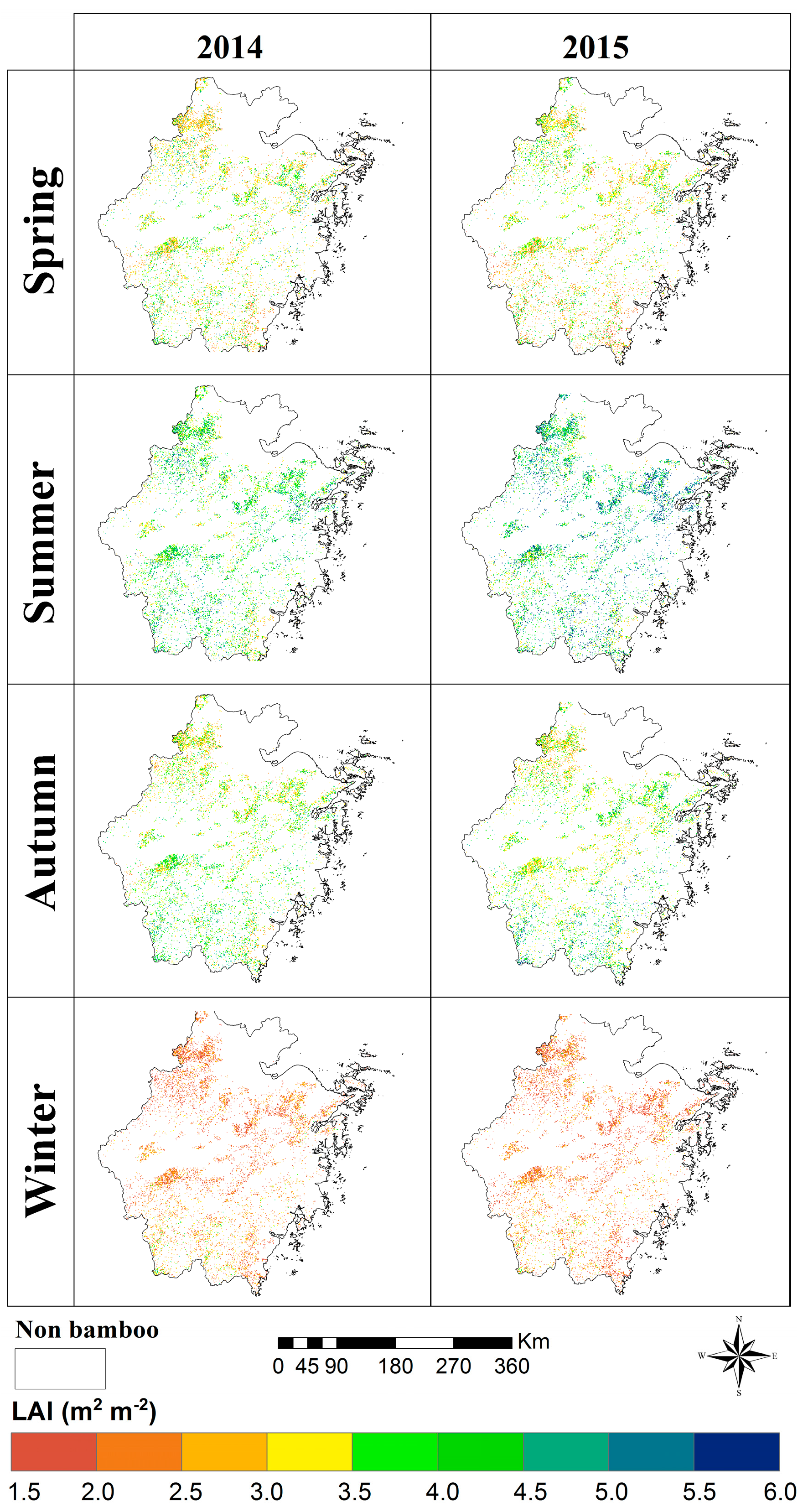
| Worldwide Reference System Path/Row | Date | Solar Azimuth Angle (°) | Solar Elevation Angle (°) | Cloud Cover (%) |
|---|---|---|---|---|
| 118/39 | 13 June 2014 | 104.06 | 69.06 | 10.03 |
| 118/40 | 13 June 2014 | 100.12 | 69.12 | 6.05 |
| 118/41 | 13 June 2014 | 96.19 | 69.09 | 7.94 |
| 119/39 | 22 July 2014 | 109.15 | 66.46 | 2.31 |
| 119/40 | 22 July 2014 | 105.69 | 66.66 | 3.09 |
| 119/41 | 22 July 2014 | 102.21 | 66.78 | 4.02 |
| 120/39 | 11 June 2014 | 104.49 | 69.09 | 1.03 |
| 120/40 | 11 June 2014 | 100.55 | 69.17 | 0.09 |
| Model | Parameter (Unit) | MBF | LBF | EBDF |
|---|---|---|---|---|
| PROSPECT5 | N | 1.04 | 2.10 | 2.15 |
| Cab (μg cm−2) | 28–55 | 30–54 | 33–65 | |
| Car (μg cm−2) | 10 | 8 | 10 | |
| Cw (g cm−2) | 0.0035 | 0.0085 | 0.0150 | |
| Cm (g cm−2) | 0.003 | 0.001 | 0.009 | |
| 4SAIL | LAI (m2 m−2) | 0.0–7.0 | 1.5–7.0 | 0.0–6.5 |
| ALA (°) | 20.2 | 19.66 | 19.65 | |
| H | 0.0003 | 0.0015 | 0.0090 | |
| θv (°) | 0–90 | 0–90 | 0–90 | |
| θs (°) | 0–90 | 0–90 | 0–90 | |
| θz (°) | 0–180 | 0–180 | 0–180 |
| Year | Seasons | LAI (m2 m−2) | ||
|---|---|---|---|---|
| Min | Max | Average ± Std. | ||
| 2014 | Spring | 1.81 | 5.53 | 3.36 E ± 0.82 |
| Summer | 1.99 | 5.88 | 4.04 B ± 0.80 | |
| Autumn | 1.94 | 5.58 | 3.57 D ± 0.71 | |
| Winter | 1.43 | 4.89 | 2.23 G ± 0.52 | |
| 2015 | Spring | 1.63 | 5.32 | 3.21 F ± 0.78 |
| Summer | 2.05 | 7.48 | 4.57 A ± 0.93 | |
| Autumn | 1.85 | 6.28 | 3.68 C ± 0.80 | |
| Winter | 1.43 | 4.44 | 2.15 H ± 0.50 | |
© 2017 by the authors. Licensee MDPI, Basel, Switzerland. This article is an open access article distributed under the terms and conditions of the Creative Commons Attribution (CC BY) license (http://creativecommons.org/licenses/by/4.0/).
Share and Cite
Mao, F.; Li, X.; Du, H.; Zhou, G.; Han, N.; Xu, X.; Liu, Y.; Chen, L.; Cui, L. Comparison of Two Data Assimilation Methods for Improving MODIS LAI Time Series for Bamboo Forests. Remote Sens. 2017, 9, 401. https://doi.org/10.3390/rs9050401
Mao F, Li X, Du H, Zhou G, Han N, Xu X, Liu Y, Chen L, Cui L. Comparison of Two Data Assimilation Methods for Improving MODIS LAI Time Series for Bamboo Forests. Remote Sensing. 2017; 9(5):401. https://doi.org/10.3390/rs9050401
Chicago/Turabian StyleMao, Fangjie, Xuejian Li, Huaqiang Du, Guomo Zhou, Ning Han, Xiaojun Xu, Yuli Liu, Liang Chen, and Lu Cui. 2017. "Comparison of Two Data Assimilation Methods for Improving MODIS LAI Time Series for Bamboo Forests" Remote Sensing 9, no. 5: 401. https://doi.org/10.3390/rs9050401






